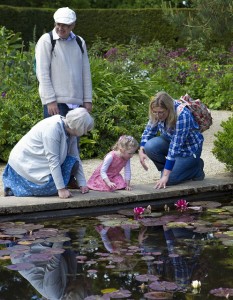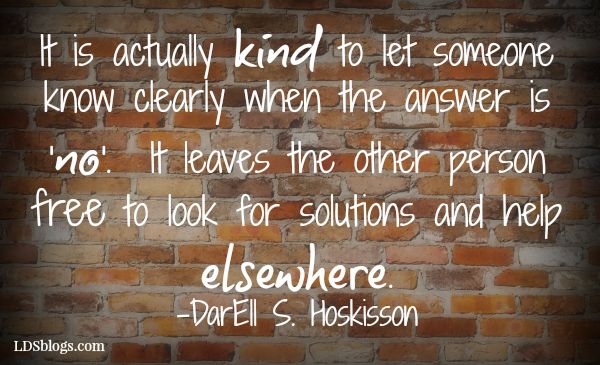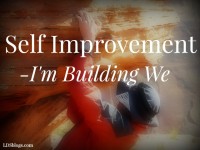At the bottom of the narrow, wooden stairway in my grandparents’ home, was a plaque on the wall of a very stern cartoon gentleman. It said, “No!” “Now what was the question?” It was given as a joke, but the idea is a little intimidating. There are many people who seem predisposed to say, “no.” It is not a problem for them to draw the line or be clear. I call them “No-ers.” But there are those of us who are “Yes-ers,” who love to please and make people happy. We love to cooperate and agree. We are predisposed to say, “Yes, now what did you want?” And both tendencies lead to some problems.
‘No-ers’ cut off discussion, in fact often prevent it from happening in the first place. They often don’t know all that people could tell them because they seem to not care, and who knows, maybe they don’t. But, they can’t judge what they don’t want to know if they never get to hear it in the first place, right?
 Yes-ers on the other hand run into all kinds of problems they didn’t intend by over scheduling themselves, compromising too much, or in other ways communicating things they do not mean because they are unclear when a simple “no” might do. It feels uncomfortable, almost like a dirty word to be so “mean.”
Yes-ers on the other hand run into all kinds of problems they didn’t intend by over scheduling themselves, compromising too much, or in other ways communicating things they do not mean because they are unclear when a simple “no” might do. It feels uncomfortable, almost like a dirty word to be so “mean.”
We all need to be able to speak more clearly and get enough information first before we send out that emphatic, decisive word either for or against. I thought it would be fun to share some of the ways I’ve learned to say “no” without having to say it. Perhaps it could stretch you no-ers out into a few more options that could lead to better cooperation, and perhaps it can help us yes-ers to stay out of so many messes of our own making. Let me know what you think.
Yes, when ….
This strategy is akin to Cinderella’s wicked step mother saying “if” …..Yes you can go to the ball if you have something appropriate to wear, if you do a thousand chores, etc. But, in Disney’s rendition, the stepmother obviously did not mean ‘yes’, she meant ‘no.’ Yes, when ….is much kinder because it really means what you say. Sometimes you want to say ‘yes,’ but you can’t because certain conditions must be met. That might mean that you have to say, “no.” However, this also may be untrue. Often we can compromise if our needs are met also. For example,
“Yes I can take you to the mall when I finish writing my article.”
“Yes you can drive the car when your homework is done and your room is clean.”
“Yes I can take you to your appointment if you can schedule it for a Thursday afternoon in the next two weeks.”
Learning that I could say ‘yes’ with conditions was so helpful to me. It is so freeing to be able to direct others into a win/win situation where you can cooperate or be helpful instead of being forced into a false choice where either way one would have to sacrifice unnecessarily.
Whose baby is it?
 That is my way of asking who really cares the most? Who is most responsible and invested in it? It could be that I’m trying to make a decision that it is best for me not to make. In these cases, I can delegate the decision or put the “baby” back in the arms of it’s mother. Decisions are often best made by those who are most affected by that decision.
That is my way of asking who really cares the most? Who is most responsible and invested in it? It could be that I’m trying to make a decision that it is best for me not to make. In these cases, I can delegate the decision or put the “baby” back in the arms of it’s mother. Decisions are often best made by those who are most affected by that decision.
For example, my husband, in an attempt to discipline the children, would often declare a consequence or punishment that I had to support. He was inadvertently causing me to have to say ‘yes’ and make time to enforce a consequence I might not have time for or agree with or ‘no’ that might teach my children talking back, disrespect, or that my husband was not really a leader in our home. Either way looked lose/lose. So, for a long time, I took the loss and rearranged my day to follow through on consequences I didn’t agree to.
In this example, how we disciplined our kids was a shared responsibility. The “baby” was ours. So, I realized that it was right for me to speak up in private and make sure that my husband knew how this affected me and what I needed. I recognized and claimed “my baby.” Together we figured out what would be appropriate consequences that we could each follow through on without punishing the other.
“Should I wear this dress to the dance?” A daughter might ask. This might be a terribly difficult yes/no question with relationship consequences either way. But, it is simple if you realize that “this baby” belongs to your daughter. “What do you think?” might be a great answer that hands it right back to her.
Who should decide? Sometimes who the “baby” belongs to is very difficult to determine. I know of two ways that work well. One is for each person (or party) to pick a number between 0 and 10 describing how intensely they care about the decision. Zero is “don’t care at all” and 10 is “very core, very invested, couldn’t care more.” With this scale you can judge who cares the most and, all else being equal, let that person decide.
Develop a Heuristic
 A heuristic is a pattern or rule you set up to help you decide or solve problems quickly. They are known for being “prone to errors.” But, if the consequences aren’t critical, and you are caught between a yes and a no answer, a heuristic can work wonders.
A heuristic is a pattern or rule you set up to help you decide or solve problems quickly. They are known for being “prone to errors.” But, if the consequences aren’t critical, and you are caught between a yes and a no answer, a heuristic can work wonders.
For instance, my husband and I worked out a personal guideline that helped us to decide if we should do things as a family or split up–one taking a child or children and the other staying home with a child or children. Since we had four children, we decided that if three were cooperative and doing okay, we wouldn’t let one cranky kid break up our opportunity for a family outing. But, if two or more were not cooperative, one of us would take turns staying home with the crabs, and the other would take the cooperative kids out.
This rule is why I got to see the Olympic torch with two of my children, and my husband did not. It was sad to miss him, but it was so, so nice to not have to deal with crying, crabby children ruining the experience for all of us. Having this rule in place helped us to cooperatively make the best of things without having to hash it out every time.
Delay your answer
If you are waiting for a person in authority to give you a yes or no answer, it can be incredibly frustrating to wait. But waiting is a great strategy if you don’t have enough information to decide. Sometimes we might accidentally answer too soon and miss opportunities we could have had if we waited. A night with a conflicting engagement might not have a conflict closer to the event, when one is cancelled or postponed. You might get sick, or your child might get sick. Sometimes we just need more information. I find it very helpful to resist that first impulse to say yes long enough to get home and seriously look at my calendar. Just waiting until I can look at my week helps me be a lot more realistic in my commitments. Noers might also find delaying helpful so they can have the time they need to think and replan to see if they can fit something in and be a little more flexible.
Just say ‘No’
If you know the answer has to be no, then everyone appreciates being let down clearly and easily. We can’t and don’t always have to explain why. Sometimes it might be for our own peace of mind or nobody’s business. I have always appreciated sincere expressions of desire to please even when a friend has to say no. My dad, in particular, couldn’t always come to everything. He essentially had to say ‘no’ to a lot of unspoken requests for him to be there. But, I always knew he wanted to come so I was rarely disappointed. We don’t need people to fix everything; we do need to feel cared about.
We can let others know that we would like to please and help them. We would like to be there for them. We might offer other things that we can do. But even if not, it is actually kind to let someone know, clearly when the answer is no. It leaves the person free to look for solutions and help elsewhere rather than wearing you both down trying to get a clear answer. Sometimes it is kindest to just say, “no.”
May your answer
fit the question.
Namaste,
DarEll S. Hoskisson
About DarEll Hoskisson
DarEll S. Hoskisson loves to do hard things, but not too hard. She shares her own challenges, goals and experiences as she guides you into a realistic path of self-reflection and self-improvement. She shares tips on how to find, know and trust yourself so you can decide if other’s suggestions are right for you.
DarEll has the world a little upside down—where work is play and play is work. She actually thinks other people’s problems are fun to try to solve and lights up with a personal challenge. She loves people, harmony, and excellence. She also loves useful things like tools and ideas that make work faster, easier and more fun.
DarEll married in 1993 and graduated from BYU (1995) with a bachelor’s degree in English and Secondary Education. Since then she was adopted by 5 children and has worked with many non-profits. She is currently a certified personal trainer and group fitness instructor—leading pilates and yoga at her local YMCA.
DarEll lives in Florida where she enjoys her family, nature, her work, and encouraging people to live well.
She periodically posts her poems, what she is learning, and service opportunities on her personal blogs:
https://personalabridgements.wordpress.com and https://darellhoskisson.wordpress.com
Twitter •




I have this problem – being a “yesser”. I know quite a few in my family who do too.
These are great stratigies to help us be more clear – You can say no and still be kind and often, as you mentioned, no is the kinder thing to say. We all need to respect each other and our limits. I love the looking for win/win solutions. I love your Heuristic example! Thank you!
I’m so glad you found it helpful. DSH